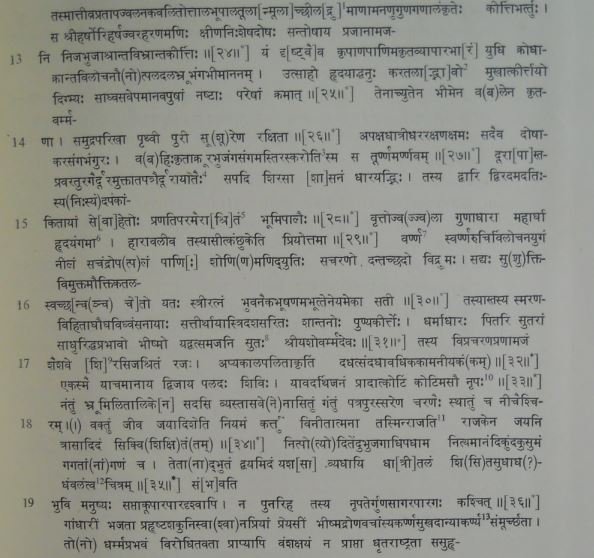|
INSCRIPTIONS OF THE CHANDELLAS OF JEJAKABHUKTI

_____________________________
[1] Some other letters originally cut in place of nmū- and dru, which were subsequently corrected.
[2] The akshara in the brackets was lost in Kielhorn’s time also, and the reading adopted here is as proposed by him.
[3] Read  . The consonant of the second of these aksharas is damaged. . The consonant of the second of these aksharas is damaged.
[4] The bracketed akshara is entirely lost.
[5] Kielhorn read -śitaṁ and corrected the first of these letters to si, to give the sense of āsitaṁ. But my
impression shows a rēpha attached to ś and thus I take the letter as Śra.
[6] The preceding letter was originally cut as  and later on altered to and later on altered to  . This verse contains a play on
vṛitta meaning (1) round and (2) conduct, and on guṇa meaning (1) thread and (2) merit. . This verse contains a play on
vṛitta meaning (1) round and (2) conduct, and on guṇa meaning (1) thread and (2) merit.
[7] The visarga is omitted here not wrongly, as Kielhorn has observed, but in accordance with the Vārttika on Pāṇini, VIII, 3, 36.
[8] This refers to the legend according to which Bhīshma was born from the Ganges (Tridaśa-sarit) by
Sāntanu. See Mbh., I, 99. 47; Mēdinī, 118, 81 (Gāṅgēyaḥ Syāt Pumān Bhīshmē).
[9] The bracketed akshara appears to have been changed to sa, which suits the sense.
[10] There is a pun here on the word pala, meaning (1) flesh and (2) a weight (and thus a coin of that
weight). Śivi is the well-known mythical king.
[11] Kielhorn read this akshara as ti and corrected it to ni, but I do not think that the emendation proposed
by him is necessary. Rājati is in the loc. absolute; the verb is ubhayapadī.
[12] Read  . The latter ha, which was repeated by mistake, has been scored off; but I fail to
find the two signs of the anusvāra also struck off, as Kielhorn observed. . The latter ha, which was repeated by mistake, has been scored off; but I fail to
find the two signs of the anusvāra also struck off, as Kielhorn observed.
[13] The pṛishṭha-mātrā of  is very thin and the consonant of is very thin and the consonant of  in appears to have been corrected.
The letter in appears to have been corrected.
The letter  is damaged by the crack. is damaged by the crack.
|